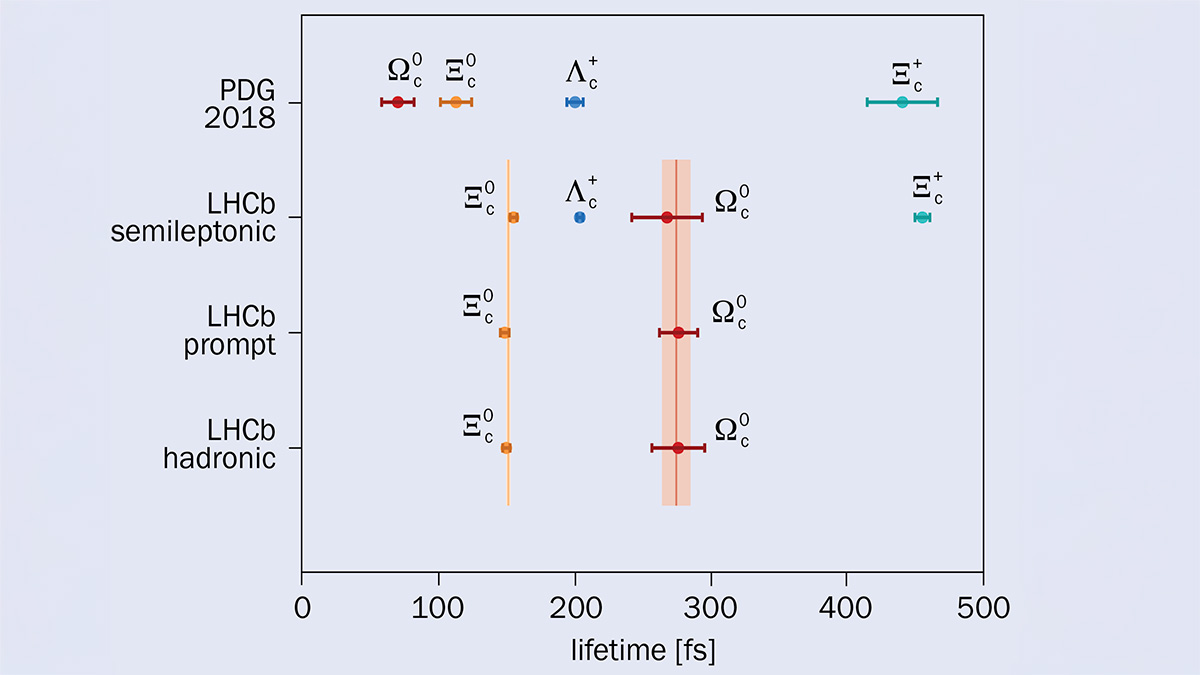A report from the LHCb experiment.
In 2018 and 2019, the LHCb collaboration published surprising measurements of the Ξc0 and Ωc0 baryon lifetimes, which were inconsistent with previous results and overturned the established hierarchy between the two. A new analysis of their hadronic decays now confirms this observation, promising insights into the dynamics of baryons.
The Λc+, Ξc+, Ξc0 and Ωc0 baryons – each composed of one charm and two lighter up, down or strange quarks – are the only ground-state singly charmed baryons that decay predominantly via the weak interaction. The main contribution to this process comes from the charm quark transitioning into a strange quark, with the other constituents acting as passive spectators. Consequently, at leading order, their lifetimes should be the same. Differences arise from higher-order effects, such as W-boson exchange between the charm and spectator quarks and quantum interference between identical particles, known as “Pauli interference”. Charm hadron lifetimes are more sensitive to these effects than beauty hadrons because of the smaller charm quark mass compared to the bottom quark, making them a promising testing ground to study these effects.
Measurements of the Ξc0 and Ωc0 lifetimes prior to the start of the LHCb experiment resulted in the PDG averages shown in figure 1. The first LHCb analysis, using charm baryons produced in semi-leptonic decays of beauty baryons, was in tension with the established values, giving a Ωc0 lifetime four times larger than the previous average. The inconsistencies were later confirmed by another LHCb measurement, using an independent data set with charm baryons produced directly (prompt) in the pp collision (CERN Courier July/August 2021 p17). These results changed the ordering of the four single-charm baryons when arranged according to their lifetimes, triggering a scientific discussion on how to treat higher-order effects in decay rate calculations.
Using the full Run 1 and 2 datasets, LHCb has now measured the Ξc0 and Ωc0 lifetimes with a third independent data sample, based on fully reconstructed Ξb– → Ξc0 (→ pK–K–π+)π– and Ω–b → Ωc0 (→ pK–K–π+)π– decays. The selection of these hadronic decay chains exploits the long lifetime of the beauty baryons, such that the selection efficiency is almost independent of the charm baryon decay time. To cancel out the small remaining acceptance effects, the measurement is normalised to the kinematically and topologically similar B– → D0(→ K+K–π+π–)π– channel, minimising the uncertainties with only a small additional correction from simulation.
The signal decays are separated from the remaining background by fits to the Ξc0 π– and Ωc0 π– invariant mass spectra, providing 8260 ± 100 Ξc0 and 355 ± 26 Ωc0 candidates. The decay time distributions are obtained with two independent methods: by determining the yield in each of a specific set of decay time intervals, and by employing a statistical technique that uses the covariance matrix from the fit to the mass spectra. The two methods give consistent results, confirming LHCb’s earlier measurements. Combining the three measurements from LHCb, while accounting for their correlated uncertainties, gives τ(Ξc0) = 150.7 ± 1.6 fs and τ(Ωc0) = 274.8 ± 10.5 fs. These new results will serve as experimental guidance on how to treat higher-order effects in weak baryon decays, particularly regarding the approach-dependent sign and magnitude of Pauli interference terms.
Further reading
LHCb Collab. 2025 arXiv:2506.13334.
